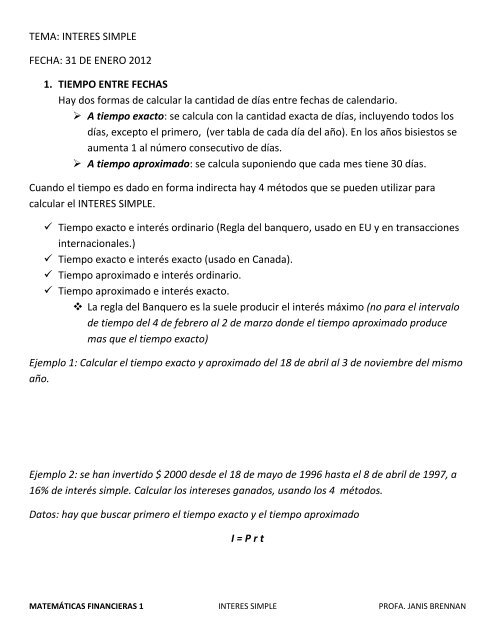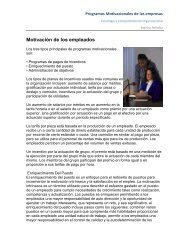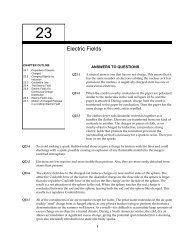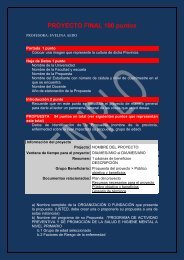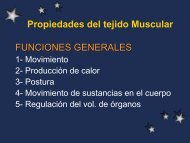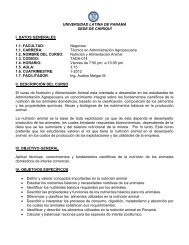TEMA: INTERES SIMPLE FECHA: 31 DE ENERO 2012 1. TIEMPO ...
TEMA: INTERES SIMPLE FECHA: 31 DE ENERO 2012 1. TIEMPO ...
TEMA: INTERES SIMPLE FECHA: 31 DE ENERO 2012 1. TIEMPO ...
You also want an ePaper? Increase the reach of your titles
YUMPU automatically turns print PDFs into web optimized ePapers that Google loves.
<strong>TEMA</strong>: <strong>INTERES</strong> <strong>SIMPLE</strong><br />
<strong>FECHA</strong>: <strong>31</strong> <strong>DE</strong> <strong>ENERO</strong> <strong>2012</strong><br />
<strong>1.</strong> <strong>TIEMPO</strong> ENTRE <strong>FECHA</strong>S<br />
Hay dos formas de calcular la cantidad de días entre fechas de calendario.<br />
‣ A tiempo exacto: se calcula con la cantidad exacta de días, incluyendo todos los<br />
días, excepto el primero, (ver tabla de cada día del año). En los años bisiestos se<br />
aumenta 1 al número consecutivo de días.<br />
‣ A tiempo aproximado: se calcula suponiendo que cada mes tiene 30 días.<br />
Cuando el tiempo es dado en forma indirecta hay 4 métodos que se pueden utilizar para<br />
calcular el <strong>INTERES</strong> <strong>SIMPLE</strong>.<br />
Tiempo exacto e interés ordinario (Regla del banquero, usado en EU y en transacciones<br />
internacionales.)<br />
Tiempo exacto e interés exacto (usado en Canada).<br />
Tiempo aproximado e interés ordinario.<br />
Tiempo aproximado e interés exacto.<br />
La regla del Banquero es la suele producir el interés máximo (no para el intervalo<br />
de tiempo del 4 de febrero al 2 de marzo donde el tiempo aproximado produce<br />
mas que el tiempo exacto)<br />
Ejemplo 1: Calcular el tiempo exacto y aproximado del 18 de abril al 3 de noviembre del mismo<br />
año.<br />
Ejemplo 2: se han invertido $ 2000 desde el 18 de mayo de 1996 hasta el 8 de abril de 1997, a<br />
16% de interés simple. Calcular los intereses ganados, usando los 4 métodos.<br />
Datos: hay que buscar primero el tiempo exacto y el tiempo aproximado<br />
I = P r t<br />
MATEMÁTICAS FINANCIERAS 1 <strong>INTERES</strong> <strong>SIMPLE</strong> PROFA. JANIS BRENNAN
2. ECUACIONES <strong>DE</strong> VALOR<br />
CADA PAGÓ TIENE<br />
UNA <strong>FECHA</strong> <strong>DE</strong><br />
VENCIMIENTO<br />
EN MATEMÁTICAS<br />
FINANCIERAS SE<br />
MANEJAN VALORES<br />
<strong>FECHA</strong>DOS<br />
EN LAS<br />
<strong>DE</strong>SICIONES<br />
FINANCIERAS<br />
ES<br />
IMPORTANTE<br />
EL DINERO TIENE<br />
VALOR CON EL<br />
<strong>TIEMPO</strong><br />
CUANDO EL DINERO<br />
VA AL FUTURO SE<br />
ACUMULA Y SE<br />
MULTIPLICA POR UN<br />
FACTOR <strong>DE</strong><br />
ACUMULACIÓN<br />
1 + RT<br />
CUANDO VA HACIA EL<br />
PASADO SE<br />
MULTIPLICA POR UN<br />
FACTOR <strong>DE</strong><br />
<strong>DE</strong>SCUENTO<br />
⬚ ⬚<br />
MATEMÁTICAS FINANCIERAS 1 <strong>INTERES</strong> <strong>SIMPLE</strong> PROFA. JANIS BRENNAN
EJEMPLO: Valores fechados equivalentes ha determinado valor fechado X.<br />
Años t<br />
años t<br />
Fecha anterior Fecha Dada Fecha Posterior<br />
X (1 + rt) -1<br />
X (1 + rt)<br />
Ejemplo 3: Una deuda de $1500 se vence en 6 meses, con un interés de 11%. Con 15% de<br />
interés simple, calcular el valor de la obligación.<br />
a) Al final de 3 meses (X)<br />
b) Al final de 12 meses(Y)<br />
Datos: el valor de la obligación en 6 meses es:<br />
1500 (1 + (0.11)6/12)<br />
= $ 1582. 50<br />
X 1582.50 Y<br />
3 meses 6 meses<br />
3 meses 6 meses 12 meses<br />
MATEMÁTICAS FINANCIERAS 1 <strong>INTERES</strong> <strong>SIMPLE</strong> PROFA. JANIS BRENNAN


